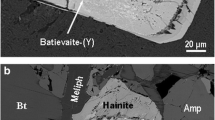Abstract
Biachellaite, a new mineral species of the cancrinite group, has been found in a volcanic ejecta in the Biachella Valley, Sacrofano Caldera, Latium region, Italy, as colorless isometric hexagonal bipyramidal-pinacoidal crystals up to 1 cm in size overgrowing the walls of cavities in a rock sample composed of sanidine, diopside, andradite, leucite and hauyne. The mineral is brittle, with perfect cleavage parallel to {10\( \bar 1 \)0} and imperfect cleavage or parting (?) parallel to {0001}. The Mohs hardness is 5. Dmeas = 2.51(1) g/cm3 (by equilibration with heavy liquids). The densities calculated from single-crystal X-ray data and from X-ray powder data are 2.515 g/cm3 and 2.520 g/cm3, respectively. The IR spectrum demonstrates the presence of SO 2−4 , H2O, and absence of CO 2−3 . Biachellaite is uniaxial, positive, ω = 1.512(1), ɛ = 1.514(1). The weight loss on ignition (vacuum, 800°C, 1 h) is 1.6(1)%. The chemical composition determined by electron microprobe is as follows, wt %: 10.06 Na2O, 5.85 K2O, 12.13 CaO, 26.17 Al2O3, 31.46 SiO2, 12.71 SO3, 0.45 Cl, 1.6 H2O (by TG data), −0.10 −O=Cl2, total is 100.33. The empirical formula (Z = 15) is (Na3.76Ca2.50K1.44)Σ7.70(Si6.06Al5.94O24)(SO4)1.84Cl0.15(OH)0.43 · 0.81H2O. The simplified formula is as follows: (Na,Ca,K)8(Si6Al6O24)(SO4)2(OH)0.5 · H2O. Biachellaite is trigonal, space group P3, a =12.913(1), c = 79.605(5) Å; V = 11495(1) Å3. The crystal structure of biachellaite is characterized by the 30-layer stacking sequence (ABCABCACACBACBACBCACBACBACBABC)∞. The tetrahedral framework contains three types of channels composed of cages of four varieties: cancrinite, sodalite, bystrite (losod) and liottite. The strongest lines of the X-ray powder diffraction pattern [d, Å (I, %) (hkl)] are as follows: 11.07 (19) (100, 101), 6.45 (18) (110, 111), 3.720 (100) (2.1.10, 300, 301, 2.0.16, 302), 3.576 (18) (1.0.21, 2.0.17, 306), 3.300 (47) (1.0.23, 2.1.15), 3.220 (16) (2.1.16, 222). The type material of biachellaite has been deposited at the Fersman Mineralogical Museum of the Russian Academy of Sciences, Moscow, Russia, registration number 3642/1.
Similar content being viewed by others
References
P. Ballirano and E. Bonaccorsi, “The Crystal Structure of Sacrofanite, the 74 Å Phase of the Cancrinite Group,” Acta Cryst. A61, (2005).
P. Ballirano, A. Maras, P. R. Buseck, “Crystal Chemistry and IR Spectroscopy of Cl- and SO4-Bearing Cancrinite-Like Minerals,” Am. Miner. 81, 1003–1012 (1996).
E. Bonaccorsi and S. Merlino, “Modular Micro-Porous Minerals: Cancrinite-Davyne Group and C-S-H Phases,” Rev. Mineral. Geochem. 57, 241–290 (2005).
F. Burragato, G. C. Parodi, and P. F. Zanazzi, “Sacrofanite: A New Mineral of the Cancrinite Group,” Neues Jahrb. Mineral. Abh. 140, 102–110 (1980).
N. V. Chukanov, R. K. Rastsvetaeva, I. V. Pekov, and A. E. Zadov, “Alloriite, Na5K1.5Ca(Si6Al6O24) (SO4)(OH)0.5 H2O: New Mineral of the Cancrinite Group,” Zap. Ross. Mineral. O-va 136(1), 82–89 (2007) [Geol. Ore Deposits, Zap. Russian Mineral. Soc. 49 (8), 752–757 (2007)].
M. Jackson and F. Marra, “Roman Stone Masonry: Volcanic Foundations of the Ancient City,” Am. J. Archaeology 110(2), 403–436 (2006).
L. Liotti and E. Tealdi, “II vulcanesimo Sabatino ed i minerali della caldra di Sacrofano,” Riv. Mineral. Ital. 2, 35–58 (1983).
Minerals, Reference Book, Vol. 5: Framework Silicates, Issue 2: Feldspathoids (Nauka, Moscow, 2003) [in Russian].
R. K. Rastsvetaeva, “Unordered Structure of New Mineral of the Cancrinite Group,” in Proceedings of the 10th International Symposium on Order, Disorder, and Properties of Oxides, 12–17 Sept., 2007 (Rostov-on-Don, 2007), Pt. III, pp. 62–63.
R. K. Rastsvetaeva and N. V. Chukanov, “Model of the Crystal Structure of B’yakellaite As a New 30-Layer Member of the Cancrinite Group,” Crystallography Rep. 53(6), 974–980 (2008).
D. de Rita and Zarlenga F., “Middle Pleistocene Geology of the “Bassa Campagna Romana”,” in Working Papers of International Congress on World of Elephants (Rome, 2001), pp. 38–42.
Author information
Authors and Affiliations
Corresponding author
Additional information
Original Russian Text © N.V. Chukanov, R.K. Rastsvetaeva, I.V. Pekov, A.E. Zadov, R. Allori, N.V. Zubkova, G. Giester, D.Yu. Puscharovsky, K.V. Van, 2009, published in Zapiski RMO (Proceedings of the Russian Mineralogical Society), 2009, Pt. CXXXVII, No. 3, pp. 57–66.
Approved by the Commission on New Minerals and Mineral Names, International Mineralogical Association December 3, 2007. IMA N 2007-044.
Rights and permissions
About this article
Cite this article
Chukanov, N.V., Rastsvetaeva, R.K., Pekov, I.V. et al. Biachellaite, (Na,Ca,K)8(Si6Al6O24)(SO4)2(OH)0.5 · H2O, a new mineral species of the cancrinite group. Geol. Ore Deposits 51, 588–594 (2009). https://doi.org/10.1134/S1075701509070071
Received:
Published:
Issue Date:
DOI: https://doi.org/10.1134/S1075701509070071




